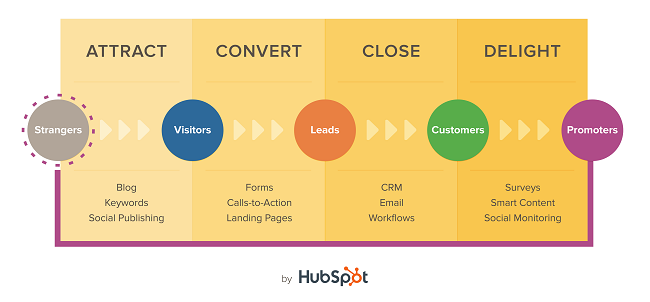Frequently, businesses embrace the opportunity to produce their first video. Significant financial resources are allocated towards an explanatory video for their homepage, however, the video production process experiences a deceleration once the project concludes.
Conversely, numerous enterprises generate diverse social videos. However, due to the practice of replicating content from videos they have previously encountered, their videos often fail to make an impression on the audience.
Given the substantial investments of time, finances, and resources, video marketing cannot be approached as a haphazard game. Rather, it necessitates the development of a comprehensive video marketing strategy that aligns with every aspect of your flywheel. This involves strategic thinking within the framework of the Inbound Marketing method.
The Inbound methodology is a Marketing and sales approach centered on attracting customers through relevant and valuable content and interactions. Each video produced should recognize the challenges faced by your audience and provide effective solutions. In essence, this content leads consumers through the stages of awareness, evaluation, and purchase of your product or service.
In the subsequent sections, we will address the categories of videos recommended for each stage depicted in the aforementioned diagram. Initiate the process by strategizing to produce a minimum of two videos for each image. It is crucial to incorporate a call to action (CTA) to guide your audience through their purchasing journey and function as a “promoter.” Refining your approach based on observed conversion rates and identified content gaps becomes essential.
Attract
The initial step in implementing an inbound approach involves attracting or transforming strangers into visitors. At this juncture, consumers are in the process of recognizing their challenges and deliberating on whether to pursue solutions. Consequently, the videos produced should empathize with their predicaments and present a potential resolution in your product or service.
Convert
Having successfully garnered video viewers and website visitors, the subsequent step is converting these visitors into leads. In the realm of Inbound Marketing content, this typically involves the acquisition of contact information through a form. Video plays a pivotal role in this process by illustrating the solution to the buyer’s problem, whether presented before a form on a landing page or as part of an offer. The objective of this video type is to educate and incite engagement.
“Conversion” videos encompass webinars filled with strategic consultation, product demonstrations sent via email, promotional videos on landing pages, typical case studies, in-depth explanations and instructional videos. For instance, whereas an “attract” video may offer tips to complete a pitch, a “convert” video could be an animated presentation explaining and analyzing the Inbound Sales methodology.
Closing orders
You have successfully captured the attention of new audiences through your videos and effectively transformed appropriate customers into leads. It is now imperative to focus on concluding these leads. Despite the significance of this stage, marketers and salesmen often tend to overlook “closing” videos. At this juncture, consumers are in the process of evaluating their choices and deciding on a purchase. Hence, the primary objective of this video genre is to encourage your audience to envision themselves utilizing your product or service, leading to positive outcomes. The preference for video over textual descriptions is evident, with four times more customers expressing a desire to watch a video about a product rather than read about it. Videos have the unique capability to showcase functionality and evoke emotions in a manner that product descriptions cannot achieve.
Delight
Following a completed purchase, there remains significant potential for video content to optimize the post-conversion phase within your flywheel. In the “delight stage” of Inbound Marketing, the objective is to consistently deliver exceptional content to users, enhancing their experience with your product or service. This particular video genre aims to inspire customers to not only adopt your brand but also to become promoters of the brand.
The initial opportunity to “delight” customers arises immediately following their purchase. This could involve sending a gratitude-infused video expressing a warm welcome to the community, or providing an instructive video to assist them in their engagement with a new purchase. Subsequently, establishing an extensive repository of educational courses and product training videos is recommended to cater to individuals who favor self-service options or seek to enhance their knowledge and proficiency.


